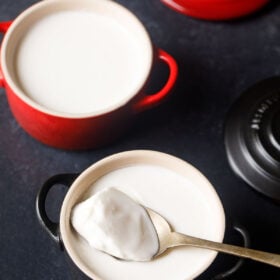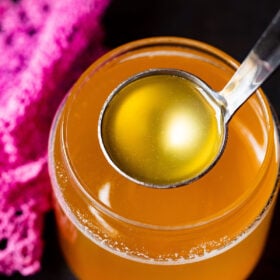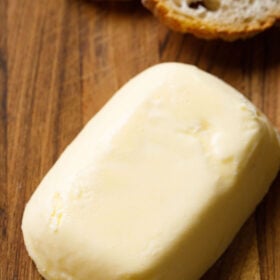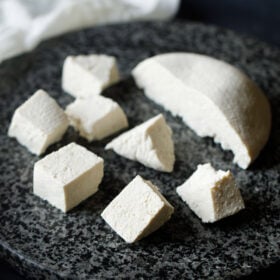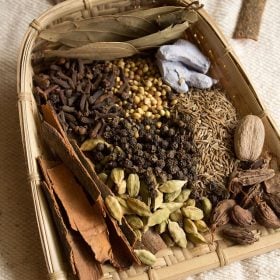Wadi or Vadi are sun-dried lentil and spices dumplings. These are made with different kinds of lentils across Northern India. While in Rajasthan, there is the Mangodi which is made from moong lentils, the Punjabi variant is made with urad dal or moong dal and even fresh green chickpeas. These sun-dried lentils dumplings are further used to add to everyday vegetable curries or rice based dishes.

About Punjabi Wadi
As I have mentioned above, basically wadis are spiced dumplings made from a thick ground lentil and spices batter that are sun-dried.
The lentils are first soaked and then ground to a thick batter with spices and salt. Small portions of the batter is then sun dried.
After sun-drying, the wadi resembles small nuggets and look dry, thick and dense. They are meaty in texture as well as in taste.
Though not exactly tasting like meat, but a little close. These dumplings are also a great substitute for meat and the Soya Chunks (soya wadi) that we get in India.

Plus they are vegan and can be made gluten-free if you do not add asafoetida (hing). You can add them to veggies and rice – even soups, pasta or noodles. They can also be fried and served as a side dish.
They soak up the sauce or gravy in which they are cooked and yet retain their texture, flavor and taste.
Generally these wadis are made in the winters when fresh green chickpeas also called as Cholia in Punjabi hits the market.
My mother-in-law makes Punjabi Wadi every year and here I share her recipe. It is really delicious and healthy.
We make the wadis with fresh green chickpeas/hara chana, moong dal or urad dal. Either use moong dal (hulled mung beans) or urad dal (hulled black gram) when making the wadis in combination with the fresh green chickpeas.
If you cannot get your hands on fresh green chickpeas, simply make these vadis with moong or urad dal.

I have seen my mother-in-law would spending so much time peeling the green chickpea pods still attached to the fresh green bunch, and then making the wadis. In fact I used to help her in making the wadi mixture and then sun drying the vadis.
Oh yes and I do have memories of peeling the chickpea pods with my family back home. We would sit together and remove the chickpeas. Later mom would just boil the fresh chickpeas and have these sprinkled with some salt and chili powder. A warm and comforting snack in the Mumbai winters.
This Punjabi Vadi is spiced but not very heavily like like the spicy Amritsari vadi.

Once you have a whole jar of wadis, you can easily add them to your veggies or rice dishes.
We make the Punjabi wadi chawal or rice. The vadis are also added to potatoes to make the Aloo wadi sabji.
At home I generally add the wadis to Lauki (Bottle Gourd) Sabji and make. I also add them a sautéed dish made with white radish.
In the lauki wadi sabji, the spiced vadiyan balances the bland bottle gourd and it seems that this combo is made for each other. Below is the photo of this dish – a recipe which I have already posted.
Another point to make a note of: Since this is a homemade recipe, we adds whole cloves to the lentil mixture. So when you are eating the wadi and not careful, you will bite into the cloves and get a not so good strong astringent taste of the cloves in your mouth. So to avoid this, I suggest you to add clove powder to the lentil batter.
If you live in a place where you don’t get enough sun, then too you can make the wadis by oven drying them. Please check the notes section below on how to make oven dried Punjabi wadi.
More DIY Recipes
DIY & Collections
DIY & Collections
DIY & Collections
Gluten Free Recipes
Please be sure to rate the recipe in the recipe card or leave a comment below if you have made it. For more vegetarian inspirations, Sign Up for my emails or follow me on Instagram, Youtube, Facebook, Pinterest or Twitter.

Punjabi Wadi | Vadi Recipe
Ingredients
- 1 cup fresh green chickpeas – in the absence of chickpeas, simply make the vadis with 2 cups of mung dal (hulled mung beans) or urad dal (hulled black gram) or ½ cup dried green chickpeas soaked overnight.
- 1 cup mung dal or urad dal
- 3 to 4 teaspoons cumin seeds
- ½ teaspoon asafoetida (hing) – the light variety
- 2 teaspoon cloves or ½ teaspoon clove powder
- 2 teaspoon black peppercorns or crushed black pepper
- salt as required
Instructions
Preparing the lentil batter
- Soak the fresh chickpeas in water for 2 to 3 hours.
- Also soak the mung dal or urad dal for 2 to 3 hours.
- Drain the chickpeas and grind it with very little water or no water to a fine, smooth and thick paste.
- Also grind the mung dal or urad dal with very little water or no water to a thick and fine, smooth paste.
- In a large bowl mix together both the chickpea paste and the mung dal or urad dal paste.
- Add all the spices and salt and mix well.
Sun-drying Vadi
- Take a large tray/plate or food safe plastic sheet.
- Keep the tray/plate on a mat in the sun.
- Drop spoonful of the the wadi mixture on the plate/tray or plastic sheet.
- You can shape them in small circles with the back of the spoon.
- Dry them in the sun for 2 to 3 days till they become hard.
- When one side is dried, then turn the wadis and dry the other side.
- You will have to turn these wadis a couple of times to ensure even drying.
- When done, store all the punjabi wadis in an air tight container.
Adding the vadis to any dish
- Rinse the vadis in water.
- Then add them to any veggie or rice based dish.
- Let them cook for 4 to 5 minutes.
- The vadis will become soft when cooked.
Notes
This Punjabi Vadi recipe post from the blog archives first published in July 2012 has been updated and republished on December 2022.

